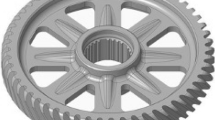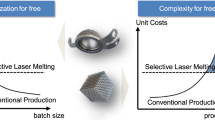Abstract
Reducing gear vibration as well as its weight is a challenging field latterly. This research deals with the manufacturing of a gear having cellular lattice body structure by using Selective Laser Melting (SLM) technology. A cellular lattice design defines a complex structure which typically cannot be fabricated by conventional manufacturing technologies. On the other hand, the SLM technology enables the production of such complex cellular lattice structures directly from their computer-aided designed (CAD) models. The cellular gear body structure was designed and optimized by employing topology optimization software ProTOp and fabricated by SLM using Ti-6Al-4V alloy. The problems faced by the researchers and the solution which enabled the manufacturing of this gear by SLM are described in this paper. To estimate the performance of the gear during operation, the sound pressure was measured and compared to the results obtained with the gear having a solid body. The experimental results show that the investigated cellular lattice structure of the gear body is well capable to reduce the mass and vibration of the gear.













Similar content being viewed by others
Data availability
No data and material are available.
References
Ji B, Han H, Lin R, Li H (2019) Failure modes of lattice sandwich plate by additive-manufacturing and its imperfection sensitivity. Acta Mech Sin Xuebao 36:430–447. https://doi.org/10.1007/s10409-019-00918-2
Calleja A, Tabernero I, Ealo JA, Campa FJ, Lamikiz A, de Lacalle LNL (2014) Feed rate calculation algorithm for the homogeneous material deposition of blisk blades by 5-axis laser cladding. Int J Adv Manuf Technol 74:1219–1228. https://doi.org/10.1007/s00170-014-6057-3
Gao W, Zhang Y, Ramanujan D, Ramani K, Chen Y, Williams CB, Wang CCL, Shin YC, Zhang S, Zavattieri PD (2015) The status, challenges, and future of additive manufacturing in engineering. Comput Des 69:65–89. https://doi.org/10.1016/j.cad.2015.04.001
Thijs L, Verhaeghe F, Craeghs T, Humbeeck JV, Kruth JP (2010) A study of the microstructural evolution during selective laser melting of Ti-6Al-4V. Acta Mater 58:3303–3312. https://doi.org/10.1016/j.actamat.2010.02.004
Maamoun AH, Xue YF, Elbestawi MA, Veldhuis SC (2018) The effect of selective laser melting process parameters on the microstructure and mechanical properties of Al6061 and AlSi10Mg alloys. Materials (Basel) 12(1):12. https://doi.org/10.3390/ma12010012
Pal S, Lojen G, Kokol V, Drstvensek I (2018) Evolution of metallurgical properties of Ti-6Al-4V alloy fabricated in different energy densities in the selective laser melting technique. J Manuf Process 35:538–546. https://doi.org/10.1016/j.jmapro.2018.09.012
Pal S, Gubeljak N, Hudak R, Lojen G, Rajtukova V, Predan J, Kokol V, Drstvensek I (2018) Tensile properties of selective laser melting products affected by building orientation and energy density. Mater Sci Eng A 743:637–647. https://doi.org/10.1016/J.MSEA.2018.11.130
Murr LE, Quinones SA, Gaytan SM, Lopez MI, Rodela A, Martinez EY, Hernandez DH, Martinez E, Medina F, Wicker RB (2009) Microstructure and mechanical behavior of Ti-6Al-4V produced by rapid-layer manufacturing, for biomedical applications. J Mech Behav Biomed Mater 2:20–32
Malý M, Höller C, Skalon M, Meier B, Koutný D, Pichler R, Sommitsch C, Paloušek D (2019) Effect of process parameters and high-temperature preheating on residual stress and relative density of Ti6Al4V processed by selective laser melting. Materials (Basel) 12(6):930. https://doi.org/10.3390/ma12060930
Dong Z, Liu Y, Wen W, Ge J, Liang J (2018) Effect of hatch spacing on melt pool and as-built quality during selective laser melting of stainless steel: modeling and experimental approaches. Materials (Basel) 12(1):50. https://doi.org/10.3390/ma12010050
Mierzejewska ŻA, Hudák R, Sidun J (2019) Mechanical properties and microstructure of DMLS Ti6Al4V alloy dedicated to biomedical applications. Materials (Basel) 12(1):176. https://doi.org/10.3390/ma12010176
Pal S, Drstvensek I (2018) Physical behaviors of materials in selective laser melting process. DAAAM Int Sci B:239–256. https://doi.org/10.2507/daaam.scibook.2018.21
Zhou S, Su Y, Gu R, Wang Z, Zhou Y, Ma Q, Yan M (2018) Impacts of defocusing amount and molten pool boundaries on mechanical properties and microstructure of selective laser melted AlSi10Mg. Materials (Basel) 12(1):73. https://doi.org/10.3390/ma12010073
Pal S, Tiyyagura HR, Drstvenšek I, Kumar CS (2016) The effect of post-processing and machining process parameters on properties of stainless steel PH1 product produced by direct metal laser sintering. Procedia Eng 149:359–365. https://doi.org/10.1016/j.proeng.2016.06.679
Zhang X, Kang J, Rong Y, Wu P, Feng T (2018) Effect of scanning routes on the stress and deformation of overhang structures fabricated by SLM. Materials (Basel) 12(1):47. https://doi.org/10.3390/ma12010047
Zhang K, Fu G, Zhang P, Ma Z, Mao Z, Zhang D (2018) Study on the geometric design of supports for overhanging structures fabricated by selective laser melting. Materials (Basel) 12(1):27. https://doi.org/10.3390/ma12010027
Álvarez Á, Calleja A, Ortega N, López De Lacalle LN (2018) Five-axis milling of large spiral bevel gears: toolpath definition, finishing, and shape errors. Metals (Basel) 8(5):353. https://doi.org/10.3390/met8050353
Alvarez Á, Calleja A, Arizmendi M et al (2018) Spiral bevel gears face roughness prediction produced by CNC end milling centers. Materials (Basel) 11(8):1301. https://doi.org/10.3390/ma11081301
Bo P, González H, Calleja A, de Lacalle LNL, Bartoň M (2020) 5-axis double-flank CNC machining of spiral bevel gears via custom-shaped milling tools — Part I: Modeling and simulation. Precis Eng 62:204–212. https://doi.org/10.1016/j.precisioneng.2019.11.015
Smith JD (2003) Gear noise and vibration, 2nd edn. CRC Press, New York
Fakhfakh T, Chaari F, Haddar M (2005) Numerical and experimental analysis of a gear system with teeth defects. Int J Adv Manuf Technol 25:542–550. https://doi.org/10.1007/s00170-003-1830-8
Fakhfakh T, Walha L, Louati J, Haddar M (2006) Effect of manufacturing and assembly defects on two-stage gear systems vibration. Int J Adv Manuf Technol 29:1008–1018. https://doi.org/10.1007/s00170-005-2602-4
Kahraman A, Blankenship GW (2008) Effect of involute tip relief on dynamic response of spur gear pairs. J Mech Des 121(2):313–315. https://doi.org/10.1115/1.2829460
Liu G, Parker RG (2008) Dynamic modeling and analysis of tooth profile modification for multimesh gear vibration. J Mech Des 130(12):121402. https://doi.org/10.1115/1.2976803
Ma H, Pang X, Feng R, Wen B (2016) Evaluation of optimum profile modification curves of profile shifted spur gears based on vibration responses. Mech Syst Signal Process 70-71:1131–1149. https://doi.org/10.1016/j.ymssp.2015.09.019
Xiao W, Li J, Wang S, Fang X (2016) Study on vibration suppression based on particle damping in centrifugal field of gear transmission. J Sound Vib 366:62–80. https://doi.org/10.1016/j.jsv.2015.12.014
Xiao W, Huang Y, Jiang H, Jin L (2016) Effect of powder material on vibration reduction of gear system in centrifugal field. Powder Technol 294:146–158. https://doi.org/10.1016/j.powtec.2016.01.038
Li S (2008) Experimental investigation and FEM analysis of resonance frequency behavior of three-dimensional, thin-walled spur gears with a power-circulating test rig. Mech Mach Theory 43(8):934–963. https://doi.org/10.1016/j.mechmachtheory.2007.07.009
Belsak A, Flasker J (2006) Method for detecting fatigue crack in gears. Theor Appl Fract Mech 46(2):105–113. https://doi.org/10.1016/j.tafmec.2006.07.002
Belšak A, Flašker J (2008) Vibration analysis to determine the condition of gear units. Stroj Vestnik/Journal Mech Eng 1(54):11–24 http://www.dlib.si/details/URN:NBN:SI:doc-QSILW60D
Mohammed OD, Rantatalo M (2016) Dynamic response and time-frequency analysis for gear tooth crack detection. Mech Syst Signal Process 66-67:612–624. https://doi.org/10.1016/j.ymssp.2015.05.015
Harl B, Predan J, Gubeljak N, Kegl M (2017) On configuration-based optimal design of load-carrying lightweight parts. Int J Simul Model 16(2):219–228. https://doi.org/10.2507/ijsimm16(2)3.369
Ramadani R, Belsak A, Kegl M, Predan J, Pehan S (2018) Topology optimization based design of lightweight and low vibration gear bodies. Int J Simul Model 17:92–104. https://doi.org/10.2507/IJSIMM17(1)419
Pal S, Kokol V, Gubeljak N et al (2019) Dimensional errors in selective laser melting products related to different orientations and processing parameters. Mater Tehnol 53:551–558. https://doi.org/10.17222/mit.2018.156
Yang J, Zhang H, Li T, Gao Z, Nie S, Wei B (2018) A profile dressing method for grinding worm used for helical gear with higher order modification profile. Int J Adv Manuf Technol 99:161–168. https://doi.org/10.1007/s00170-018-2459-y
González H, Calleja A, Pereira O, Ortega N, López de Lacalle L, Barton M (2018) Super abrasive machining of integral rotary components using grinding flank tools. Metals (Basel) 8(1):24. https://doi.org/10.3390/met8010024
CAESS ProTOp. ProTOp - Topology Optimization Software, from https://caess.eu/, accessed on 05.02.2020
User AS (2014) Abaqus 6.14. Dassault Systèmes Simulia Corp, Provid RI, USA. https://doi.org/10.1017/CBO9781107415324.004
Pal S, Lojen G, Kokol V, Drstvenšek I (2019) Reducing porosity at the starting layers above supporting bars of the parts made by selective laser melting. Powder Technol 355:268–277. https://doi.org/10.1016/j.powtec.2019.07.059
Pal S, Lojen G, Hudak R, Rajtukova V, Brajlih T, Kokol V, Drstvenšek I (2020) As-fabricated surface morphologies of Ti-6Al-4V samples fabricated by different laser processing parameters in selective laser melting. Addit Manuf 33:101147. https://doi.org/10.1016/j.addma.2020.101147
Mazur M, Leary M, Sun S, Vcelka M, Shidid D, Brandt M (2016) Deformation and failure behaviour of Ti-6Al-4V lattice structures manufactured by selective laser melting (SLM). Int J Adv Manuf Technol 84:1391–1411. https://doi.org/10.1007/s00170-015-7655-4
Yamamoto S, Azuma H, Suzuki S, Kajino S, Sato N, Okane T, Nakano S, Shimizu T (2019) Melting and solidification behavior of Ti-6Al-4V powder during selective laser melting. Int J Adv Manuf Technol 103:4433–4442. https://doi.org/10.1007/s00170-019-03384-z
Ramadani R, Kegl M, Predan J, et al (2018) Influence of cellular lattice body structure on gear vibration induced by meshing. Stroj Vestnik/Journal Mech Eng 64(10), 611-620. https://doi.org/10.5545/sv-jme.2018.5349
Mills DW, Allen RL (2004) Signal analysis time, frequency, scale and structure.
Funding
The authors want to thank the Erasmus Mundus JoinEU-SEE PENTA scholarship program, Slovenian Research Agency (research core funding No. P2-0063 and P2-0157), as well as CAESS company for the research support.
Author information
Authors and Affiliations
Contributions
Riad Ramadani: conceptualization, methodology, visualization, and writing—original draft. Snehashis Pal: conceptualization, methodology, visualization, and writing—original draft. Marko Kegl: writing (review and editing) and funding acquisition. Jozef Predan: investigation. Igor Drstvensek: investigation, writing (review and editing), and funding acquisition. Stanislav Pehan: supervision, conceptualization, methodology, visualization, and writing—review and editing. Ales Belsak: supervision, conceptualization, methodology, visualization, and writing—review and editing.
Corresponding author
Ethics declarations
Ethical approval
The consent of this research is not involved with the human and animal participants.
Consent to participate
No participation is included in this research.
Consent to publish
The authors agree with the Copyright Transfer Statement.
Competing interests
The authors declare no competing interests.
Additional information
Publisher’s note
Springer Nature remains neutral with regard to jurisdictional claims in published maps and institutional affiliations.
Rights and permissions
About this article
Cite this article
Ramadani, R., Pal, S., Kegl, M. et al. Topology optimization and additive manufacturing in producing lightweight and low vibration gear body. Int J Adv Manuf Technol 113, 3389–3399 (2021). https://doi.org/10.1007/s00170-021-06841-w
Received:
Accepted:
Published:
Issue Date:
DOI: https://doi.org/10.1007/s00170-021-06841-w




